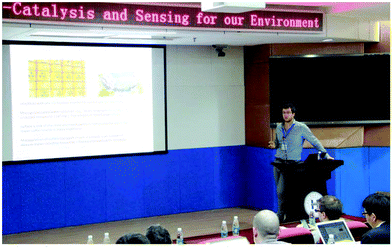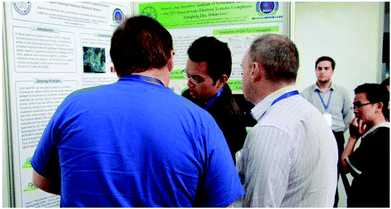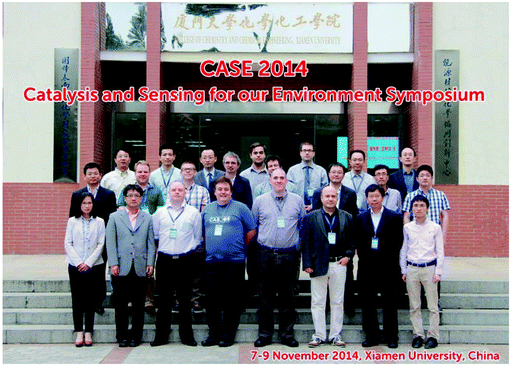The CASE 2014 symposium: Catalysis and sensing for our environment, Xiamen 7th–9th November 2014
John S.
Fossey
* and
William D. G.
Brittain
*
School of Chemistry, University of Birmingham, Edgbaston, Birmingham, West Midlands B15 2TT, UK. E-mail: j.s.fossey@bham.ac.uk; wdb996@bham.ac.uk
First published on 19th December 2014
Introduction
A warm autumn weekend, in the beautiful city of Xiamen in the South of China, saw the 6th CASE symposium begin with anticipation for the new findings to be presented and the potential for new collaborations to develop.The Catalysis and Sensing for our Environment (CASE) group was originally founded in 2008 by UK academics John S. Fossey, Steven D. Bull and Tony D. James as a forum to kick start cooperative research and exchange ideas in the molecular recognition arena, with the focus on catalysis and sensing. A close knit group of researchers with like-minded interests, they soon realised the value of the CASE meeting and endeavoured to replicate the opportunities created by such a forum coupled to a research conference. A few conference rules were decided, the first being the local organisers must do everything they can to ensure the symposium is free to attend, so as to facilitate wide ranging attendance. To permit this, all presenters cover their own travel costs. The formula of free attendance and free flowing discussion means researchers are always eager to take up the opportunity to take part in a CASE conference.
After the first meeting at Bath University in 2008, meetings have taken place at East China University of Science and Technology (ECUST), the University of Birmingham, Shanghai Institute of Organic Chemistry and the University of Texas at Austin. Last November saw Professor Yun-Bao Jian (Dean of the College of Chemistry & Chemical Engineering at Xiamen University) take over the reins and host the 2014 CASE symposium in the picturesque setting of Xiamen University.
Conference review
The exciting programme kicked off with a presentation from Professor Yitao Long, who amongst a number of other speakers has attended most of the preceding CASE conferences. He described his work in the area of spectrochemical sensing on single nanoparticles. This included his work describing the interactions between RNA aptamers and photochromic spiropyrans, and their subsequent sensing through the use of α-hemolysin nanopores (Fig. 1).1 | ||
| Fig. 1 Interaction of RNA aptamers with photochromic spiropyrans, Zhang et al.1 Reproduced with permission from Chem. Sci., 2014, 5, 2642–2646. Copyright © 2014 Royal Society of Chemistry. | ||
Next Dr Robert Elmes (University of Maynooth) detailed work on the sensing of sulphate ions, where receptors designed with specific hydrogen bonding interactions based around diketocyclobutane derivatives had been synthesised to specifically bind tetrahedral ions. He commented on the potential for this sensing regime in biochemistry and biomedical applications.2 Dr Elmes represents a CASE success story, as a PhD student he won a poster prize at a previous CASE conference and CASE 2014 represents his first presentation as an independent academic researcher (Fig. 2 and 3).
 | ||
| Fig. 2 Binding of a sulfate ion with a squaramide based receptor, Elmes et al.2 Reproduced with permission from Chem. – Eur. J., 2014, 20, 7373–7380. Copyright © 2014 John Wiley and Sons. | ||
 | ||
| Fig. 3 Dr Robert Elmes, former CASE poster prize winner as a PhD student, now delivering his first presentation as an independent researcher. Photo credit Shi Chen. | ||
Professor Shoufa Han (Xiamen University) told the audience about investigations into carbohydrate directed molecular theranostics for intra operative tumour ablation,3 which could be an exciting method for the detection and photothermal removal of surgically exposed tumours.
After a short break the next session saw Professor Jian Zhou (East China Normal University) report on his investigations into the formation of asymmetric tetrasubstitued carbon stereogenic centres, more specifically his attempts at introducing fluorine or fluroalkyl substituents at these centres.4 Then Simon Lewis (Bath University) gave an in depth account of an unexpected “aliphatic Friedel–Crafts” reaction mediated by aluminium trichloride first seen by Baddeley in 1960.5 He showed how the mechanism has been elucidated and the potential applications in catalysis have been developed.6 Dr Steven D. Bull (University of Bath) covered a wide range of topics including the asymmetric synthesis of a myriad of potentially biologically active molecules exploiting innovative approaches to classical reactions such as Baeyer–Villiger, acylation and nucleophilic substitution.7 The morning session was brought to a close by Professor Chuanliu Wu (Xiamen University) who talked about the development of high quality peptide probes and intracellular peptide delivery systems.8
The afternoon saw Professor Leyong Wang (Nanjing University) discuss the use of supramolecular vesicles for cancer drug delivery. He showed the synthesis of pH and photo-responsive pillar[6]arene-based supramolecular nanocarriers for cancer treatment.9 Next, Professor Xiaojun Peng described fluorescence imaging of cancer by molecular response to COX-2 enzymes.10
Professor Thorri Gunnlaugsson (Trinity College Dublin) next took to the floor. As a CASE veteran with a reputation for delivering exciting talks jam packed with new results, the audience's anticipation filled the room. He, as ever, did not disappoint, and showed the journey from molecular design of polypyridyl complexes through to applications in imaging and therapy.11 The tough job of following up this presentation fell to Professor Engin Akkaya (Bilkent University) who dazzled the audience with his chemoluminescent approach to imaging.12 An influential presentation that led to lots of follow-up discussion and the generation of new ideas as the conference progressed. The day's programme ended with a presentation from Professor Xuhong Qian (president of ECUST). His presentation told of the lessons learned through detailed structure elucidation. He showed the audience how his own research has influenced others and where the current challenges lie at the cutting edge of his research (Fig. 4 and 5).13
 | ||
| Fig. 4 Luminescent ruthenium(II) polypyridyl functionalized gold nanoparticles, Elmes et al.11 Reproduced with permission from J. Am. Chem. Soc., 2011, 133, 15862–15865. Copyright © 2011 ACS. | ||
 | ||
| Fig. 5 Chemiluminescence sensing of fluoride ions using a self-immolative amplifier Turan et al.12 Reproduced with permission from Org. Lett., 2014, 16, 1680–1683. Copyright © 2014 ACS. | ||
The evening saw an invigorating poster session, and with news that three poster prizes were up for grabs and judges circulating the session it was a resounding success. Some of the more junior members of the conference cohort took full advantage of the chance to talk about their research with leaders in their field and develop new ideas (Fig. 6 and 7).
 | ||
| Fig. 6 Poster session at CASE 2014 Xiamen. The judges quiz one eventual prize winner as another looks on. Photo credit Shi Chen. | ||
The next day started with a presentation from Dr John S. Fossey (University of Birmingham, co-author of this conference report and co-founder of the CASE network). He began by highlighting how this conference series has been so important for his own research. He started by detailing some of the cooperative work that has arisen from ideas discussed at CASE conferences,14–23 and moved on to pose a question to the audience about an unexplained observation in his current, unpublished, work. Next, Professor Christopher G. Frost (University of Bath) told the audience about his catalytic sensor activation. The subject was perfect for the assembled audience, in that it elegantly showed how coupling catalysis and sensing can deliver results otherwise unachievable.24 The sensor system he reported will become a point of care diagnostic device for use in the clinic. Following this, another point of care diagnostic system was reported in the presentation of Professor Zhi Zhu (Xiamen University) where microfluidics was the key to delivering an extremely useful sensing system (Fig. 8).25
 | ||
| Fig. 8 The principle of DNA cross-linked hydrogel for signal amplification and visual detection Zhu et al.25 Reproduced with permission from Angew. Chem., Int. Ed., 2010, 49, 1052–1056. Copyright © 2010 John Wiley and Sons. | ||
Professor Tony D. James (University of Bath and co-organiser of CASE 2014) gave an account of how his pioneering research in saccharide recognition has led to the development of chemosensors for glucose through to potential early warning systems for diseases such as Alzheimer's.26 The new challenges in this field centre on distinguishing between different glycoproteins for disease diagnosis. Professor Jian-Feng Li gave a presentation on the use of new aspects in SERS, namely a technique called shell-isolated nanoparticle enhanced spectroscopy (SHINERS).27 The SHINERS technique might be useful for detection of pesticide residues in the food industry. The final research presentation was given by Dr A. Toby A. Jenkins, who detailed his unique approaches to developing smart wound dressings and responsive films.28
After an invigorating day, and before closing remarks, the RSC Inorganic Chemistry Frontiers poster prizes were awarded. Judges commented that all participants gave really enthusiastic accounts of their work but three winners had to be chosen and they were, in no particular order: Mr William Brittain (University of Birmingham and co-author of this conference report), Dr Shuo-Hui Cao (Xiamen University) and Miss Yuan Yuan (Xiamen University) (Fig. 9).
Closing remarks from Professor Tony D. James and Professor Yun-Bao Jiang thanked the attendees and let the audience know that the next three CASE symposia had already begun to be arranged. The next CASE symposium will take place in Dublin in 2015, the one after that in Bath in 2016 and the 9th CASE symposium will be held at Nanjing University in 2017. With that news participants were already discussing dates and arrangements to meet up at future CASE conferences and build on the ideas and relationships founded at this CASE conference.
The founding committee look forward to the next CASE symposium in Dublin and can be contacted directly for details of attendance and sponsorship.
Authors
Fig. 10 shows the authors of this report.John S. Fossey (left) is a senior lecturer in synthetic chemistry at the University of Birmingham (UK). He works at the interface of catalysis and sensing and is co-founder of the CASE network. William D. G. Brittain (right) is a PhD student (University of Birmingham, supervisors: John S. Fossey, Birmingham, and Benjamin Buckley, Loughborough). His research interests include the catalytic asymmetric generation of quaternary stereogenic centres bearing heterocycles.
Acknowledgements
JSF would like to acknowledge the University of Birmingham for continued support. WDGB would like to thank the University of Birmingham, the universities postgraduate travel fund and the RSC postgraduate travel fund.References
- X. Zhang, J. Zhang, Y.-L. Ying, H. Tian and Y.-T. Long, Chem. Sci., 2014, 5, 2642–2646 RSC.
- R. B. P. Elmes, K. K. Y. Yuen and K. A. Jolliffe, Chem. – Eur. J., 2014, 20, 7373–7380 CrossRef CAS PubMed.
- X. Wu, M. Yu, B. Lin, H. Xing, J. Han and S. Han, Chem. Sci., 2015, 6, 798–803 RSC.
- J.-S. Yu, Y.-L. Liu, J. Tang, X. Wang and J. Zhou, Angew. Chem., Int. Ed., 2014, 53, 9512–9516 CrossRef CAS PubMed.
- G. Baddeley, B. G. Heaton and J. W. Rasburn, J. Chem. Soc., 1960, 4713–4719 RSC.
- C. L. Lyall, M. Sato, M. Uosis-Martin, S. F. Asghar, M. D. Jones, I. H. Williams and S. E. Lewis, J. Am. Chem. Soc., 2014, 136, 13745–13753 CrossRef CAS PubMed.
- R. J. Wakeham, J. E. Taylor, S. D. Bull, J. A. Morris and J. M. J. Williams, Org. Lett., 2013, 15, 702–705 CrossRef CAS PubMed.
- C. Wu, S. Wang, L. Brülisauer, J.-C. Leroux and M. A. Gauthier, Biomacromolecules, 2013, 14, 2383–2388 CrossRef CAS PubMed.
- Q. Duan, Y. Cao, Y. Li, X. Hu, T. Xiao, C. Lin, Y. Pan and L. Wang, J. Am. Chem. Soc., 2013, 135, 10542–10549 CrossRef CAS PubMed.
- H. Zhang, J. L. Fan, J. Y. Wang, S. Z. Zhang, B. R. Dou and X. J. Peng, J. Am. Chem. Soc., 2013, 135, 11663–11669 CrossRef CAS PubMed.
- R. B. P. Elmes, K. N. Orange, S. M. Cloonan, D. C. Williams and T. Gunnlaugsson, J. Am. Chem. Soc., 2011, 133, 15862–15865 CrossRef CAS PubMed.
- I. S. Turan and E. U. Akkaya, Org. Lett., 2014, 16, 1680–1683 CrossRef CAS PubMed.
- Y. Liu, Y. F. Xu, X. H. Qian, Y. Xiao, J. W. Liu, L. Y. Shen, J. H. Li and Y. X. Zhang, Bioorg. Med. Chem. Lett., 2006, 16, 1562–1566 CrossRef CAS PubMed.
- M. Wang, Y.-H. Shi, J.-F. Luo, W. Du, X.-X. Shi, J. S. Fossey and W.-P. Deng, Catal. Sci. Technol., 2011, 1, 100–103 CAS.
- Z. Wang, J. J. Ye, R. Wu, Y. Z. Liu, J. S. Fossey, J. G. Cheng and W. P. Deng, Catal. Sci. Technol., 2014, 4, 1909–1913 CAS.
- L.-L. Qu, D.-W. Li, J.-Q. Xue, W.-L. Zhai, J. S. Fossey and Y.-T. Long, Lab Chip, 2012, 12 Search PubMed.
- X. Wu, Z. Li, X. X. Chen, J. S. Fossey, T. D. James and Y. B. Jiang, Chem. Soc. Rev., 2013, 42, 8032–8048 RSC.
- A. Feula, S. S. Dhillon, R. Byravan, M. Sangha, R. Ebanks, M. A. Hama Salih, N. Spencer, L. Male, I. Magyary, W.-P. Deng, F. Muller and J. S. Fossey, Org. Biomol. Chem., 2013, 11, 5083–5093 CAS.
- X. Sun, S.-Y. Xu, S. E. Flower, J. S. Fossey, X. Qian and T. D. James, Chem. Commun., 2013, 49, 8311–8313 RSC.
- S. Y. Xu, B. Hu, S. E. Flower, Y. B. Jiang, J. S. Fossey, W. P. Deng and T. D. James, Chem. Commun., 2013, 49, 8314–8316 RSC.
- A. Stephenson-Brown, H.-C. Wang, P. Iqbal, J. A. Preece, Y. Long, J. S. Fossey, T. D. James and P. M. Mendes, Analyst, 2013, 138, 7140–7145 RSC.
- H.-C. Wang, H. Zhou, B. Chen, P. M. Mendes, J. S. Fossey, T. D. James and Y.-T. Long, Analyst, 2013, 138, 7146–7151 RSC.
- X. Sun, Q. Xu, G. Kim, S. E. Flower, J. P. Lowe, J. Yoon, J. S. Fossey, X. Qian, S. D. Bull and T. D. James, Chem. Sci., 2014, 5, 3368–3373 RSC.
- B. J. Marsh, L. Hampton, S. Goggins and C. G. Frost, New J. Chem., 2014, 38, 5260–5263 RSC.
- Z. Zhu, C. C. Wu, H. P. Liu, Y. Zou, X. L. Zhang, H. Z. Kang, C. J. Yang and W. H. Tan, Angew. Chem., Int. Ed., 2010, 49, 1052–1056 CrossRef CAS PubMed.
- S. D. Bull, M. G. Davidson, J. M. H. van den Elsen, J. S. Fossey, A. T. A. Jenkins, Y.-B. Jiang, Y. Kubo, F. Marken, K. Sakurai, J. Zhao and T. D. James, Acc. Chem. Res., 2013, 46, 312–326 CrossRef CAS PubMed.
- J. F. Li, X. D. Tian, S. B. Li, J. R. Anema, Z. L. Yang, Y. Ding, Y. F. Wu, Y. M. Zeng, Q. Z. Chen, B. Ren, Z. L. Wang and Z. Q. Tian, Nat. Protoc., 2013, 8, 52–65 CrossRef CAS PubMed.
- M. Laabei, W. D. Jamieson, R. C. Massey and A. T. A. Jenkins, PLos One, 2014, 9, e87270 Search PubMed.
| This journal is © the Partner Organisations 2015 |



